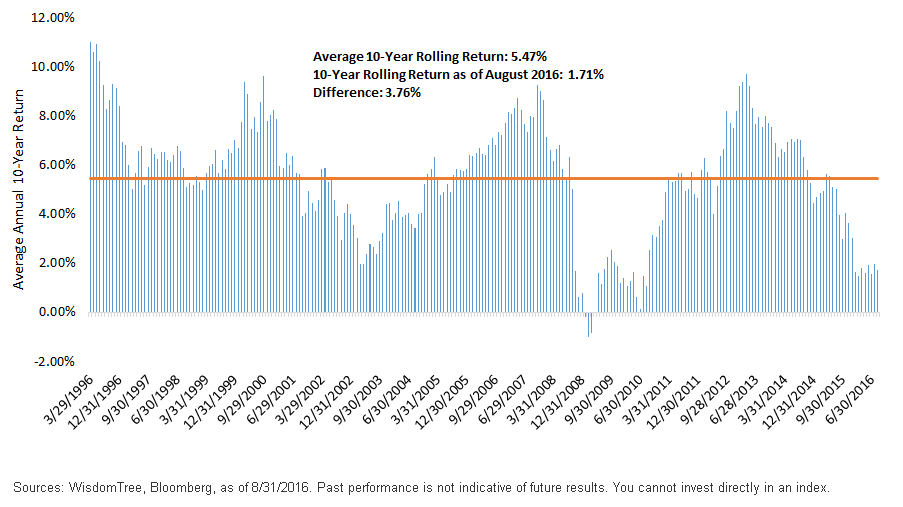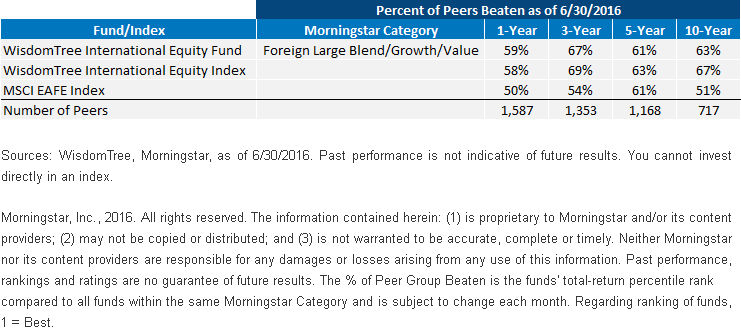How Easy Is It to Beat EAFE?



 Given the MSCI EAFE’s paltry returns during this period, it might seems as though it must have been easy for most actively managed international funds to beat EAFE over this period. But the truth is, of the 717 Foreign Value, Foreign Blend and Foreign Growth funds that Morningstar tracks, the MSCI EAFE Index actually outperformed 51% of them. So even during a period when EAFE generated low-single-digit returns that ranked in its lower decile, roughly one in two foreign funds still did not outperform the benchmark.
This is one of the reasons many investors are increasingly looking to international exchange-traded funds (ETFs) as an alternative to actively managed mutual funds. One ETF that did beat EAFE over the last decade was WisdomTree’s core product in this category: the WisdomTree International Equity Fund (DWM). DWM tracks an unhedged WisdomTree Index that includes virtually all the investable dividend-paying stocks in the developed world, outside the U.S. and Canada. There are typically more than 2,000 such dividend-paying stocks. Each June, WisdomTree weights each company in this Index based on the dollar value of the cash dividends it pays. After fees and expenses, DWM outperformed the MSCI EAFE Index by 45 basis points (bps) per year, beating 92% of its peers in the Foreign Large Value category tracked by Morningstar over that 10-year period. If we expand the universe to the group of 717 Large-Cap Value, Blend and Growth funds, DWM beat 63% of them in the 10 years ending June 2016, with its underlying WisdomTree Index beating two-thirds of the competition over the last decade. WisdomTree’s dividend-weighted approach was able to achieve these results despite the fact that the MSCI EAFE Growth Index outperformed the MSCI EAFE Value Index by 266 bps per year over this period. (For standardized returns of DWM, click here.)
Given the MSCI EAFE’s paltry returns during this period, it might seems as though it must have been easy for most actively managed international funds to beat EAFE over this period. But the truth is, of the 717 Foreign Value, Foreign Blend and Foreign Growth funds that Morningstar tracks, the MSCI EAFE Index actually outperformed 51% of them. So even during a period when EAFE generated low-single-digit returns that ranked in its lower decile, roughly one in two foreign funds still did not outperform the benchmark.
This is one of the reasons many investors are increasingly looking to international exchange-traded funds (ETFs) as an alternative to actively managed mutual funds. One ETF that did beat EAFE over the last decade was WisdomTree’s core product in this category: the WisdomTree International Equity Fund (DWM). DWM tracks an unhedged WisdomTree Index that includes virtually all the investable dividend-paying stocks in the developed world, outside the U.S. and Canada. There are typically more than 2,000 such dividend-paying stocks. Each June, WisdomTree weights each company in this Index based on the dollar value of the cash dividends it pays. After fees and expenses, DWM outperformed the MSCI EAFE Index by 45 basis points (bps) per year, beating 92% of its peers in the Foreign Large Value category tracked by Morningstar over that 10-year period. If we expand the universe to the group of 717 Large-Cap Value, Blend and Growth funds, DWM beat 63% of them in the 10 years ending June 2016, with its underlying WisdomTree Index beating two-thirds of the competition over the last decade. WisdomTree’s dividend-weighted approach was able to achieve these results despite the fact that the MSCI EAFE Growth Index outperformed the MSCI EAFE Value Index by 266 bps per year over this period. (For standardized returns of DWM, click here.)

 Conclusion
Returns for the EAFE Index over the past decade were low in absolute terms and low relative to its own history. That 10-year underperformance relative to the S&P 500 Index may actually be signaling that this is a good time to take a fresh look at international stocks. For investors interested in a dividend-weighted ETF that has a history of generating both more dividend income and greater total returns than the EAFE Index, click for more information on DWM, the WisdomTree International Equity Fund.
Unless otherwise noted, data source is Bloomberg, as of 8/31/2016.
Conclusion
Returns for the EAFE Index over the past decade were low in absolute terms and low relative to its own history. That 10-year underperformance relative to the S&P 500 Index may actually be signaling that this is a good time to take a fresh look at international stocks. For investors interested in a dividend-weighted ETF that has a history of generating both more dividend income and greater total returns than the EAFE Index, click for more information on DWM, the WisdomTree International Equity Fund.
Unless otherwise noted, data source is Bloomberg, as of 8/31/2016.
Important Risks Related to this Article
There are risks associated with investing, including possible loss of principal. Foreign investing involves special risks, such as risk of loss from currency fluctuation or political or economic uncertainty. Funds focusing their investments on certain sectors increase their vulnerability to any single economic or regulatory development. This may result in greater share price volatility. Please read the Fund’s prospectus for specific details regarding the Fund’s risk profile.
Diversification does not eliminate the risk of experiencing investment losses.
Dividends are not guaranteed, and a company currently paying dividends may cease paying dividends at any time.



